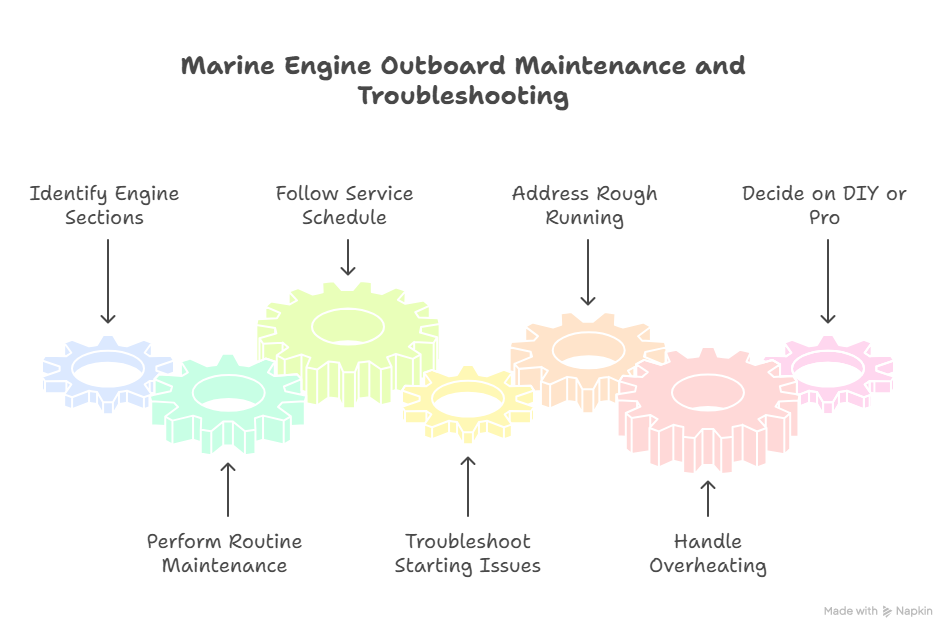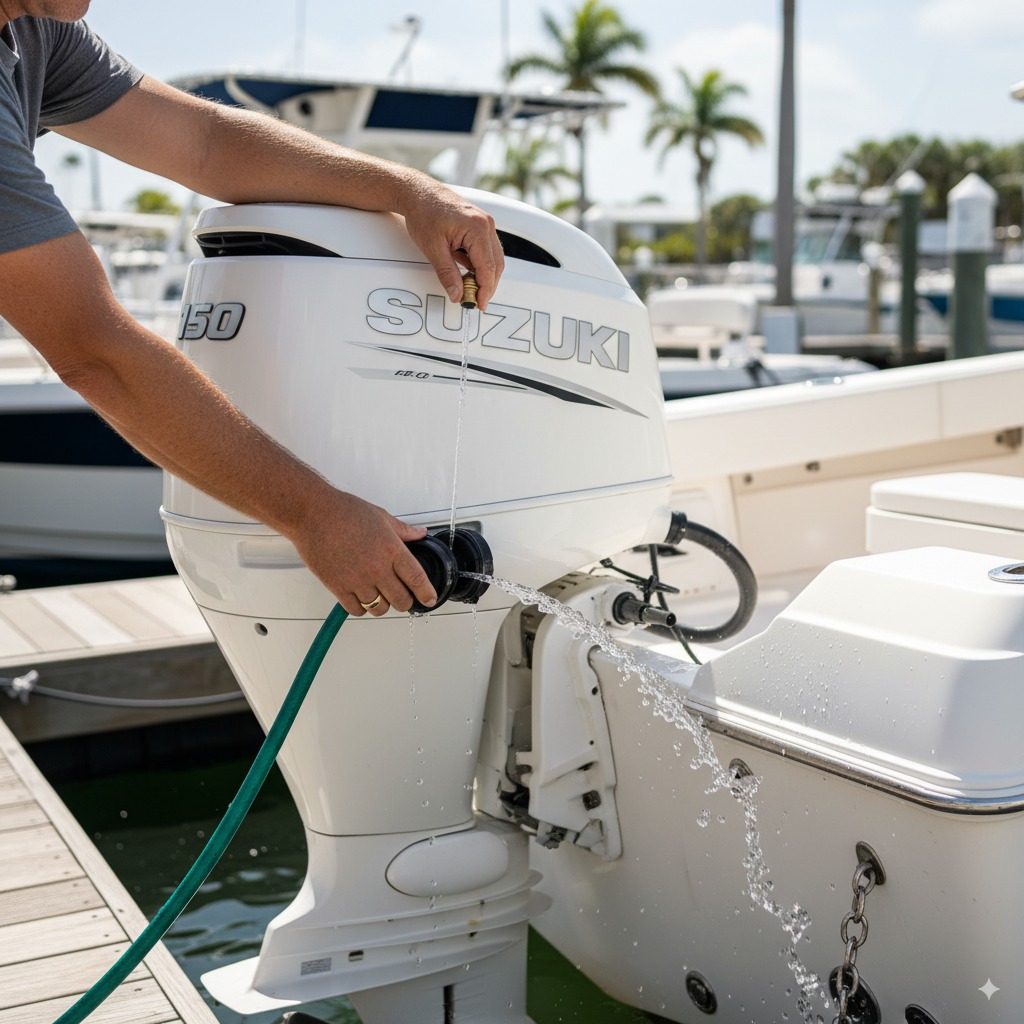I’ve been a marine tech in South Florida for over 15 years, and I’ve seen it all. But the most common story I hear starts the same way: a perfect day on the water ruined by an engine that decided to quit. Last spring, a woman named Maria brought me her family’s Boston Whaler. They were miles offshore when their marine engine outboard just sputtered and died. They had to get a tow back, which cost them a fortune and a lot of stress.
The culprit? A ten-dollar fuel filter that hadn’t been changed in three years.
That’s what this guide is all about. It’s not about complex engineering degrees. It’s about showing you how a little bit of knowledge and a few simple habits can keep your marine engine outboard from ever leaving you stranded. I want to give you the confidence to pop the cowling, know what you’re looking at, and tackle the small stuff yourself. Let’s turn that anxiety into expertise.
Table of Contents
Getting to Know Your Outboard: What’s Under the Cowling?
A marine engine outboard is a marvel of self-contained engineering. The engine, transmission, and propeller are all in one unit hanging off your transom. Understanding the basic layout is the first step to feeling comfortable with it.
- The Powerhead: This is the heart, located at the top under the cowling. It’s where the combustion happens—pistons, spark plugs, fuel system, all that good stuff.
- The Mid-Section: This is the long leg that connects the powerhead to the lower unit. It contains the driveshaft and exhaust.
- The Lower Unit (Gearcase): This is the part that’s in the water. It houses the gears that transfer power to the propeller and contains the water pump that cools your engine.
Knowing these three basic sections helps you understand what’s going on. When a mechanic talks about a “water pump issue,” you’ll know they’re talking about the lower unit. It makes a world of difference.
The Routine: Your Game Plan for a Healthy Engine
Proactive maintenance is the cheapest insurance you can buy for your marine engine outboard. Here’s the simple, real-world schedule I give to all my clients.
After Every Single Trip
This takes five minutes, and it’s non-negotiable, especially in saltwater.
- Flush it Out: Use earmuffs or the built-in flushing port and run fresh water through the engine for at least 5 minutes. This gets the salt out, which is the number one killer of outboards.
- Quick Look-See: Pop the cowling and just look. Do you see any new drips, loose wires, or anything that looks out of place? You’d be surprised what you can catch early.
My Recommended Service Schedule
Here’s a simple table for the bigger service items. This is what I do in my shop.
| Service Task | My Recommendation | Why It Matters |
|---|---|---|
| Engine Oil & Filter (4-Strokes) | Every 100 hours or once a year | Clean oil is the lifeblood of your engine. |
| Lower Unit Gear Oil | Every 100 hours or once a year | Protects your gears. Milky oil means you have a water leak—a big red flag! |
| Fuel Filter(s) | Every 100 hours or once a year | A clogged filter will starve your engine and leave you stranded. |
| Water Pump Impeller | Every 200 hours or every 2 years | This little rubber part is the only thing keeping your engine from overheating. Cheap insurance. |
| Spark Plugs | Inspect yearly, replace as needed | They tell you how your engine is burning fuel. |
| Anodes (Zincs) | Inspect yearly, replace when 50% gone | These sacrifice themselves to save your engine from corrosion. |
Your owner’s manual is your best friend. Stick to its schedule, but use this as a general guide. A well-maintained marine engine outboard is a happy one.
Troubleshooting 101: What to Do When It Won’t Go
Even the best marine engine outboard will have a bad day. When it happens, don’t just start randomly replacing parts. Think like a mechanic.
- Engine Won’t Start? This is the most common call I get.
- Start Simple: Is the kill switch clip in place? Is the engine in neutral? Is the fuel tank vent open? You’d be amazed how often it’s one of these.
- Check Fuel: Squeeze the primer bulb. Is it firm? If not, you may have a leak or a bad connection. Do you have gas? (Yes, I have to ask).
- Engine Runs Rough or Stalls?
- This is almost always a fuel problem. Start with the easiest fix: replace the fuel filter. A clogged filter is a common culprit.
- Old fuel can also cause issues. If the gas in your tank has been sitting for months, especially with ethanol, it could be the problem.
- Overheating Alarm Goes Off?
- Shut the engine off immediately. This is serious.
- Check the water intake screens on the lower unit. Are they clogged with seaweed or a plastic bag?
- Look at the “telltale” stream. Is water spitting out? If not, your water pump impeller has likely failed.

DIY vs. Calling Me: Know Your Limits
I love it when my clients want to do their own basic marine engine outboard maintenance. But it’s just as important to know when to call a pro.
You Can Totally Do This:
- Oil and filter changes
- Gear lube changes
- Spark plug replacement
- Fuel filter replacement
- Flushing and basic lubrication
Better Call a Pro For This:
- Anything involving electrical diagnostics (other than basic checks)
- Carburetor rebuilds (unless you’re very patient)
- Water pump/impeller replacement (if you’re not confident)
- Any internal engine work (powerhead issues)
- Persistent problems you can’t figure out
There’s no shame in calling for help. A good mechanic can diagnose in an hour what might take you a frustrating weekend.
FAQ: Questions I Answer Every Day
How long should my marine engine outboard last?
With proper care, a modern outboard can easily last 2,000-3,000 hours or more. I’ve seen 20-year-old motors that run like new because the owner was meticulous. Neglect it, and you could kill it in 500 hours.
Is ethanol-free gas really that important?
For older carbureted motors, yes, it’s a huge deal. Ethanol can eat old fuel lines and gum up carburetors. For modern fuel-injected engines, it’s less critical, but I still recommend using a fuel stabilizer.
What’s the single most important maintenance task?
Flushing the engine with fresh water after every saltwater use. Hands down. Salt corrosion is a silent killer.
What are those little metal things on the lower unit?
Those are sacrificial anodes (often called zincs). They are designed to corrode instead of the more expensive metal parts of your marine engine outboard. Check them yearly and replace them when they are about half-gone.
I found metal shavings on the magnetic drain plug of my lower unit. Is that bad?
Yes, that’s bad. A few tiny fuzz-like shavings can be normal wear, but if you see actual chips or a lot of shavings, it’s a sign of a gear or bearing problem inside your gearcase. It’s time to call a mechanic.
Conclusion: You’ve Got This
Taking care of your marine engine outboard isn’t black magic. It’s about consistency, paying attention, and knowing when to ask for help. By doing the simple things right—flushing after each use, changing your fluids on schedule, using good fuel—you can dramatically extend the life of your motor and save yourself a world of headaches.
You are now armed with the knowledge to be a confident, proactive boat owner. So, pop that cowling, get to know your engine, and take pride in keeping it in top shape. A reliable marine engine outboard is your ticket to freedom on the water. Now go enjoy it.
Author Bio
I’m Alex, a 15-year marine technician in South Florida, ABYC-certified. My specialty is marine engine outboard repair and maintenance. I’ve worked on everything from vintage 2-strokes to the latest 4-stroke models at marinas like Dinner Key and Bahia Mar, helping boaters keep their adventures powered and reliable.


Leave a Reply